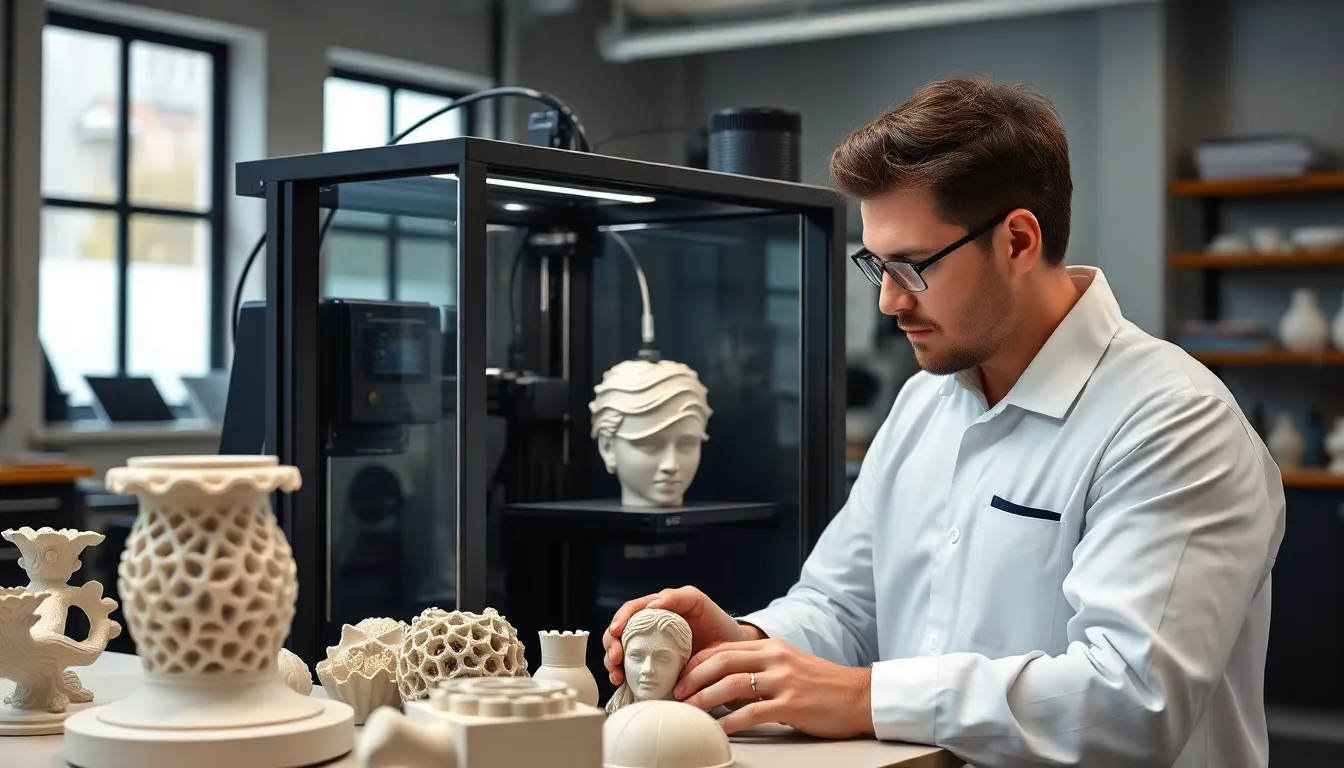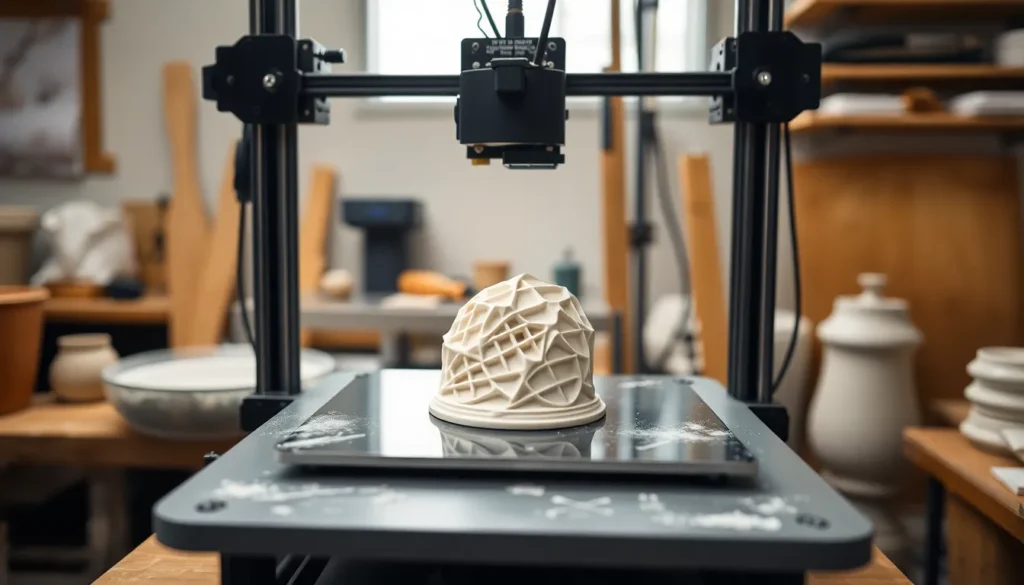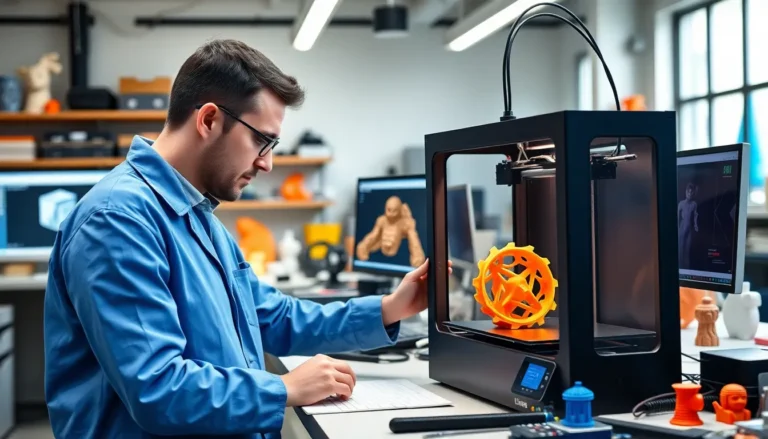Table of Contents
ToggleImagine a world where your wildest design dreams come to life with just a few clicks. Enter ceramic 3D printing, the magical fusion of art and technology that’s turning heads and reshaping industries. Gone are the days of tedious crafting and endless molding. With a 3D printer humming away in the corner, creativity flows faster than a barista on a Monday morning.
Overview of Ceramic 3D Printing
Ceramic 3D printing enables the production of complex ceramic structures using digital designs. This innovative approach leverages additive manufacturing techniques, which layer materials to create objects. Various methods exist, including binder jetting, material extrusion, and stereolithography, each with unique applications and capabilities.
Applications of ceramic 3D printing span industries like aerospace, healthcare, and art. In aerospace, companies utilize this technology for lightweight, high-performance components. Healthcare professionals explore it for custom implants and dental prosthetics. Artists adopt ceramic 3D printing to push creative boundaries, producing intricate and personalized pieces.
Materials used in ceramic 3D printing include various clay and porcelain types, providing diverse aesthetic and functional properties. These materials exhibit strength, heat resistance, and bio-compatibility, making them suitable for numerous applications. Different post-processing techniques, such as sintering and glazing, enhance the durability and appearance of the final products.
Ceramic 3D printing reduces waste compared to traditional manufacturing methods, promoting sustainability. The precise material deposition minimizes excess, addressing environmental concerns. Rapid prototyping also accelerates the design process, allowing for quicker iterations and reduced costs.
The future of ceramic 3D printing looks promising, with ongoing advancements in technology and materials. Researchers explore new formulations that enhance performance and expand capabilities. As industries adopt these innovations, ceramic 3D printing will play an increasingly vital role in modern manufacturing and design.
Benefits of Ceramic 3D Printing

Ceramic 3D printing offers distinct advantages that enhance design and functionality in various applications.
Enhanced Design Flexibility
Ceramic 3D printing enables intricate designs that traditional methods cannot achieve. Complex geometries become accessible, allowing designers to experiment freely with shapes and forms. Curved structures or fine details exemplify how this technology expands creative possibilities. Rapid prototyping facilitates quick iterations, streamlining the design process. Professionals adapt designs easily based on specific needs, creating customized solutions for clients. Furthermore, the ability to integrate multiple materials yields unique composites, enhancing aesthetics and functionality alike. Modular pieces can also be produced, facilitating versatile applications across industries.
Improved Material Properties
Ceramic 3D printing improves the material properties of finished products through innovative processes. Sintering transforms printed structures into robust components, enhancing density and strength. Heat resistance stands out as a critical advantage, making ceramics suitable for high-temperature applications. Bio-compatibility further broadens the scope for healthcare applications, especially in implants and dental prosthetics. Different types of clays and porcelain provide varied aesthetic and functional characteristics, appealing to diverse industry requirements. Custom formulations allow for specific property enhancements, such as increased durability or reduced weight, expanding usability across sectors.
Applications of Ceramic 3D Printing
Ceramic 3D printing demonstrates versatility across various fields, showcasing its potential in industrial and artistic domains.
Industrial Uses
Industries leverage ceramic 3D printing for functional components in aerospace, automotive, and healthcare sectors. Aerospace companies create lightweight and durable parts, enhancing fuel efficiency and performance. In the automotive sector, manufacturers utilize custom ceramic components for high-temperature applications, optimizing engine performance. Healthcare professionals adopt this technology for tailored implants and prosthetics, improving patient outcomes. The manufacturing process allows for rapid prototyping and reduced waste, demonstrating a shift toward sustainable production practices. Companies benefit from reduced costs while increasing design flexibility.
Artistic Creations
Artists embrace ceramic 3D printing, allowing for intricate designs that were previously challenging to achieve. Sculptors and designers craft personalized pieces, merging aesthetics with technology. Custom works, including tiles and decorative items, emerge through the innovative process, reflecting individual styles and contemporary trends. Various clays and glazes contribute unique textures and finishes to each creation. This technology fosters creativity, enabling artists to experiment without the limitations of traditional crafting techniques. Many creators appreciate the ability to bring imaginative concepts to life with precision and detail.
Process of Ceramic 3D Printing
Ceramic 3D printing involves several critical steps that ensure successful production. Each step contributes to the overall quality and effectiveness of the printed ceramic object.
Material Preparation
Material preparation focuses on the selection and formulation of ceramic materials. Clay and porcelain serve as popular choices for their unique properties. Specific additives may be mixed to optimize flow, enhance strength, or improve surface finish. Before printing, the material must undergo thorough testing to achieve the desired characteristics. Formulation adjustments are often necessary to meet specific application requirements, ensuring that the final product aligns with performance standards.
Printing Techniques
Printing techniques vary based on specific applications and desired outcomes. Binder jetting, material extrusion, and stereolithography represent the main methods used in ceramic 3D printing. Binder jetting employs a liquid binding agent to fuse ceramic powder while material extrusion utilizes a paste-like material for layer-by-layer construction. Stereolithography, on the other hand, relies on light to cure photosensitive resins. Each technique offers unique advantages, such as production speed, resolution, and material compatibility, making them suitable for different sectors.
Post-Processing Methods
Post-processing methods significantly enhance the final appearance and durability of ceramic prints. Sintering plays a crucial role by subjecting printed parts to high temperatures, promoting particle fusion and increasing strength. Glazing may follow this process to improve aesthetics and provide a smooth finish. Additional methods, like polishing and surface treatments, can further refine the product. These steps not only improve functionality but also elevate the visual appeal of the ceramics, resulting in high-quality finished items.
Challenges and Limitations
Ceramic 3D printing faces several challenges that can hinder widespread adoption. Material brittleness poses significant issues, as ceramics tend to be fragile compared to metals and plastics. This fragility limits the potential applications in high-stress environments, such as aerospace and automotive.
Cost factors also play a critical role. High material costs and initial investment in sophisticated printers can deter small businesses from entering the market. Competitors may find cheaper alternatives in traditional manufacturing methods that already exist.
Print speed can be a constraint. Longer production times for complex geometries often delay project timelines. Designers may experience frustration when trying to quickly prototype intricate designs, making rapid iterations difficult.
Post-processing requirements present additional hurdles. Techniques like sintering and glazing require skill and precision, adding to the total production time. Inadequate post-processing can lead to inconsistent quality, impacting the final product’s durability and aesthetics.
Limited material options exist. Many available ceramics are specially formulated for specific applications, restricting flexibility in design and production. Diverse applications across industries call for a broader range of material choices.
Print resolution can also be a limiting factor. While advancements improve this aspect, achieving high resolution remains challenging in comparison to other 3D printing technologies. Fine details in intricate designs could suffer during the printing process.
Environmental considerations factor into the conversation as well. Although ceramic 3D printing reduces waste compared to traditional methods, energy-intensive processes like sintering can still contribute to environmental impacts. Balancing sustainability with performance is crucial for future developments.
These challenges highlight the complexities within ceramic 3D printing. Addressing these limitations is essential for enhancing its viability in various sectors.
Ceramic 3D printing stands at the forefront of innovation in design and manufacturing. Its ability to create complex structures with precision opens new avenues across various industries. The blend of art and technology allows for unique creations that were once impossible with traditional methods.
Despite the challenges associated with material brittleness and production costs, the advantages of this technology are undeniable. Enhanced design flexibility and sustainability make ceramic 3D printing a valuable tool for both industrial applications and artistic expression.
As advancements continue to emerge, ceramic 3D printing is poised to redefine what’s possible in manufacturing and design, paving the way for a more innovative and sustainable future.





